USS Los Alamos AFDB-7
Floating Drydock

Back Aft Models. 1/700th Scale Cast and Print Resin.
Reviewed by Devin Poore, April 2022
|
Auxiliary Floating Drydocks have been in use
since WWI and before in the United States Navy. Built in sections that
can be reconfigured to the length of the ship they're supporting, they
are not powered and are towed to forward-deployed bases to allow major
ship repairs closer to deployment areas, eliminating the need for U.S.
ships to return to the United States. The specifications for Los Alamos
and her sisters, according to the U.S. Navy Museum website, and
Wikipedia: "An AFDB would have a crew of 600 to 1,000 men, a fresh-water
distilling plant and was otherwise self-sustaining. They had a rail
traveling 15-ton capacity crane with an 85-foot radius and two or more
support barges. To pump water from the tanks, there were two 24-in
discharge pumps on each section, each pump rated 15,000 gpm. For
electricity, there were two 350-kw diesel AC generators on each
section, producing 440 volts 3-phase 60-cycle power. AFDBs had steam
plants to run the pumps. Each section could store 65,000 gallons of fuel
oil to supply the ships under repair. Crew lived in barracks ships,
called APL, that docked next to the AFDB."
Completed in 1945, Los Alamos only made it as far west
as Mare Island before the end of the Second World War. Placed in reserve
in 1946, she was towed to the east coast, where she remained, until
reactivated in 1961. Utilizing only four of her original seven sections,
she was towed to Holy Loch, Scotland, for use as an advanced repair
base for the U.S. ballistic missile submarine fleet. She remained in
service there until 1994, when she was reassembled using six of her
original seven sections -- the seventh section had been turned over to
the U.S. Army as a floating power plant, later to be used as a target in
a SINKEX -- and sent to the Keppel AmFELS Shipyard, in Brownsville,
Texas, where she is known as the Solomon Ortiz Dry Dock. She is in use to this day. |
USS Los Alamos. Photo by JOC Fred J. Klinkenberger, USN - U.S. DefenseImagery photo VIRIN: DN-ST-87-02364, via WikiPedia.
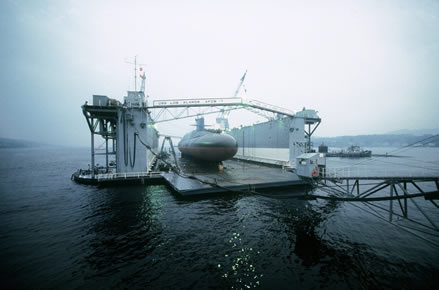
|
| CAST RESIN PARTS |
The majority of the kit's parts are cast resin.
The main structure is made up of the four interlocking pontoons. They
are cast cleanly, with minimal flash, the only air bubbles on the bottom
where they won't be visible, or fill easily if the builder chooses to
do so. The walls are straight and vertical, with no warpage in any of
the pieces.
The other, larger pieces, are cast on two sheets, with the resin
backing sheet being so thin that it breaks free of the parts with
minimal pressure; very little flush-sanding will be required. One sheet
has the gantry decks, which cap the edges of the pontoons once
assembled. The other sheet contains the two large outrigger decks that
affix to either end, bumpers, cowl vents, and the keel blocks. There are
some air bubbles in the keel blocks that will need filling and squaring
before they can be installed. The vents also show some short-casting on
a couple of the pieces, but there are spares elsewhere in the kit.
The remainder of the kit comes in three small plastic bags. One
bag contains three nice yard craft, "Mike Boats", cast in once-piece,
and very well detailed. There are thin casting wafers on the bottom of
each that should come off easily with flush-sanding. The second bag
contains the resin components for the dock's crane, such as the legs,
counter weight, control cab, etc. The third bag contains the remainder
of the small parts, which are mostly piping and cowl vents. Even with
all of these small resin parts lumped into one plastic bag - a common
practice, I know, but one I still don't care for - there doesn't appear
to be any breakage of the piping. The parts are attached to larger resin
casting blocks, so care will be needed to remove them; I suggest either
scoring along the seam between part and block with the back of a sharp
knife blade, or careful razor sawing. There are spare parts for many of
the pieces, too, which is nice considering their delicate nature.
|
|
 |
 |
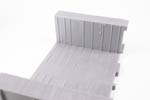 |
|
|
|
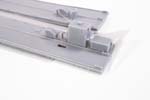 |
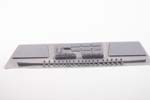 |
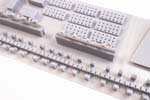 |
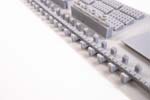 |
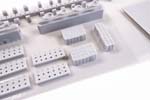 |
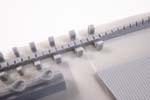 |
 |
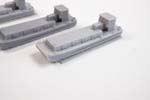 |
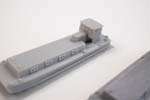 |
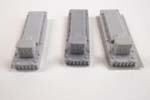 |
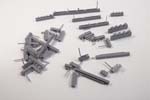 |
 |
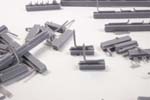 |
 |
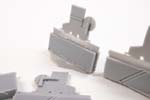 |
 |
|
 |
| BRASS and DECALS |
The brass comes in three small sheets, each
protected on both sides by plastic film. Railings, gantry legs, ladders,
and all of the other delicate structures are covered here, including
railings for the three "Mike Boats". The sheets are .006" thick, which
is quite thin, but it's of a heavy density brass, so it maintains its
shape well while handling.
The small decal sheet has the Los Alamos's name and hull number,
appropriate flags, and 16 sets of depth markings. That seems like a lot
of depth markings, but I guess if you're dealing with something that's
built to sink intentionally, you want to make sure exactly how deep it
is at all given points on the hull. |
|
|
|
|
| INSTRUCTIONS |
The instructions are nine sheets of 8.5" X 11"
paper, double-sided and laser-printed. The first sheet is a photo of the
actual dock, with specifications and the unit's service chronology, as
well as tips for working with brass and resin model kit parts. The next
two pages are a parts inventory of all resin and brass in the kit, that
not only calls out the part numbers, but also tells you what the parts
are, a nice touch that I wish all kit manufacturers would emulate. The
remainder of the pages are dedicated to construction, with each step
described in detail, accompanied by close-up photos of the section in
question. They are quite thorough and despite the many resin and brass
parts, the care taken in creating these directions means that assembly
should be straight-forward. |
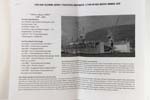 |
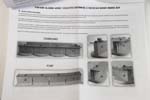 |
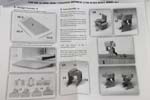 |
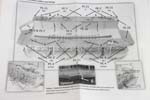 |
| CONCLUSIONS |
This is a well-done kit of a unique subject. It
is what I lovingly refer to as an "old school resin kit", though, so
there is a little work involved. For those of us that cut our teeth on
resin ship kits from Blue Water Navy, Iron Shipwrights, White Ensign,
and the others, there won't be anything out of your skill set here, and
with the sturdy brass and excellent instructions, it wouldn't be out of
the skill set for most as a first-time resin kit. As mentioned, some of
the pieces do have issues with air bubbles, but there are enough extras
that those parts that can't be easily filled and sanded, you'll likely
have a replacement already available in the kit.
Highly recommended.
Thank you to Back Aft models for the review sample. You can
find Back Aft models on eBay, in the CarlOmaha store, where you can find
this kit, a clever variation of it that's short-cast so that it looks
as if it's sunken for accepting a ship, and other detail accessories.
You can access the story by clicking on the logo to the right.
|
|

© ModelWarships.com
|